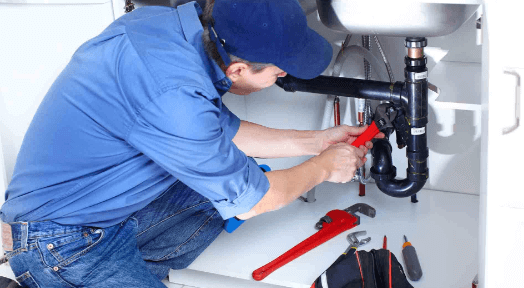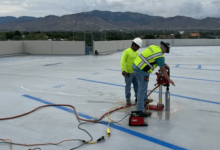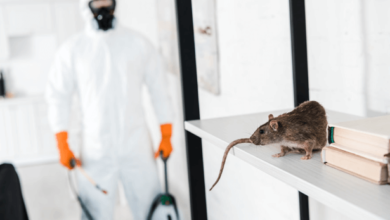How to Install New Construction Plumbing

There are many factors to consider when installing new construction plumbing. First, you’ll need to identify the walls that need to be moved to make room for a new shower or tub. You’ll also need to remove any drywall or cables that may be in the way. Using a tape measure, you can make sure the pipes will fit where you want them to.
Rough-in stage of construction
The rough-in stage of new construction plumbing involves determining where all of the plumbing lines will go. This process also involves identifying the locations of the drains and faucets. Once these areas are identified, the plumbers can begin the process of laying the necessary water supply lines for the kitchen, laundry room, and bathrooms. Once the rough-in stage is completed, the plumbing lines will need to be tested for leaks, and the entire system will have to be pressure-tested to ensure that all of the lines are working properly.
Before the plumbing contractor can begin rough-in plumbing, the framing process needs to be complete. It is important that the plumber has the correct plans, product specifications, and cabinet layouts for the home. The plumber will also need to walk through the framed home to make sure that everything is in place. During the walk-through, the plumber will need to verify the locations of plumbing fixtures, such as sinks, water heaters, and washer/dryer hookups. He will also need to connect water and drain lines to the main water supply valves.
In addition to plumbing materials, electrical work must be completed. If the work is not complete, the building inspector will have to approve it before the project can continue. In some cases, the plumber may have to make changes, which will delay the project. When the rough-in stage is completed correctly, there won’t be a chance for slab leaks.
Once the mechanical and electrical rough-in stages are complete, the plumbing and HVAC systems can be installed. This includes the installation of ductwork. This stage will also include installation of gas lines.
Components of a plumbing system
A plumbing system is comprised of a variety of components that transport water to different locations, including a water heater. The plumbing system also includes drain pipes to transport dirty water to the city sewer system. Drain pipes are part of most plumbing projects. They connect to standard fixtures and lead out of the structure to either the city sewer system or a private septic system.
Plumbing is an essential part of any building, including a home. It supplies water to various areas, including the kitchen and bathrooms. Water is supplied to these outlets through the distribution system of pipes. As such, it is critical to understand how this system works in order to avoid costly repairs later.
Plumbing installation is typically a two-stage process. The first step is setting sewer accommodation stubs, which connect the home’s sewer line to the municipal sewerage system. These are set before the concrete foundation is poured. The next phase of plumbing installation is rough-in, which involves laying basic lines without final connections. This is usually done before drywall is installed.
During the process, a plumbing permit is required, which must be obtained before any work begins. Plumbing permits require a plumbing diagram that outlines the pipe sizes and angles of the vents and drainage systems. The building inspector will use the plumbing diagram to ensure that the plumbing system is safe to operate.
Codes that apply to new construction
There are many different codes that apply to plumbing installations in new construction projects. While the National Uniform Plumbing Code is the national standard, some cities and states also have specific plumbing codes. These codes are intended to ensure that your home’s plumbing system is installed safely and securely. When working with a contractor, you should always check with your local building department to ensure that all of your plumbing installation requirements are met.
Plumbing systems in existing buildings should also comply with the relevant state codes. For example, the Existing Building Code in New York State applies to residential buildings that use truss-type or pre-engineered wood construction. In addition, any building under the jurisdiction of a state department or agency must comply with the Residential Code of New York State.
Install New Construction Plumbing-Choosing a plumber
When it comes to new construction projects, one of the most crucial things to consider is the plumber. Because plumbers perform a number of crucial jobs, it is important to choose someone with the right expertise for the job. It is a good idea to ask about their training and credentials to ensure that they will be performing the plumbing work properly. You should also ask about their experience in the trade and whether they are familiar with best practices in the industry.
If you’re unsure of the qualifications of a plumber, you should check with the state licensing board. A licensed plumber has met certain minimum requirements to obtain their license and must maintain their license to work. Also, make sure that the plumber has liability insurance and workers’ compensation insurance. You should also check references and check with the Better Business Bureau to ensure that the plumber is trustworthy.
When choosing a plumber for new construction, it is best to set aside a certain amount of budget for the job. A professional plumber will install the plumbing system in your new home, ensuring that it will function properly for many years. Even if you know nothing about plumbing, it’s better to hire a licensed plumber than to try and do it yourself. If you don’t have enough experience, you can damage your new home by making mistakes.
The price of a plumber is important, but the skills of a plumbing professional are just as important. A plumber must have the necessary knowledge to understand blueprints, communicate with designers, and understand the goals of the project. He must also know how to work with other professionals to complete the project as smoothly as possible. One of the biggest misconceptions about plumbing is that any plumber can do any type of plumbing. While a plumber may be good at unclogging a toilet, his expertise should be focused on the specific type of plumbing the project requires.
Install New Construction Plumbing-Getting a permit
If you’re planning to install new plumbing, you should start by getting a permit. The first place to check for plumbing permit requirements is your county’s building and safety department. Most counties have a webpage with information on plumbing permits and other trades. Make sure to read all the information carefully.
Building permits are required for many construction projects, including plumbing and electrical work. The process can take anywhere from three weeks to a year, depending on how detailed your application is, the requirements of the approving agencies, and the volume of applications waiting to be processed. For residential construction, the permit approval process takes an average of three months.
Plumbing and heating permits are required for any construction project in New York State. Permits are also necessary if you’re moving appliances, adding electrical outlets, or tearing down walls. The process can vary depending on the specific project, but it’s always best to check with the building department before starting any work.
Obtaining a building permit is critical to ensuring safety and quality. It also protects the public by preventing risks and ensuring contractors don’t cut corners. Without a permit, your new construction project may be shut down and re-done. This will affect your home’s resale value and can end up costing you money.
Plumbing permits are required for large projects, but even small jobs can require a permit to meet building codes. Regardless of the type of plumbing you’re planning on doing, a permit will protect your local tradespeople and help your community by generating tax revenue. While there are national plumbing codes to help plumbing professionals standardize their work, state and county regulations will usually supersede these.







